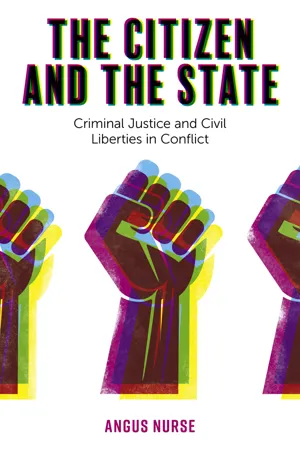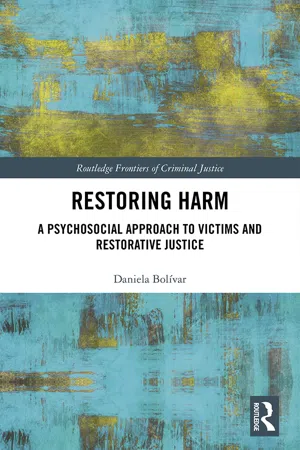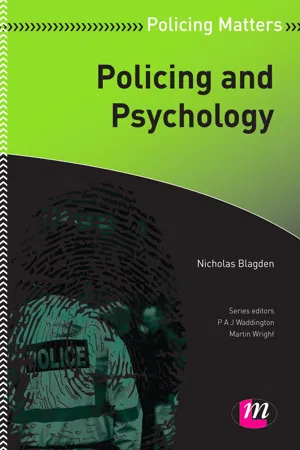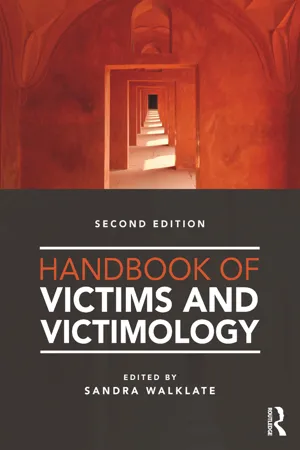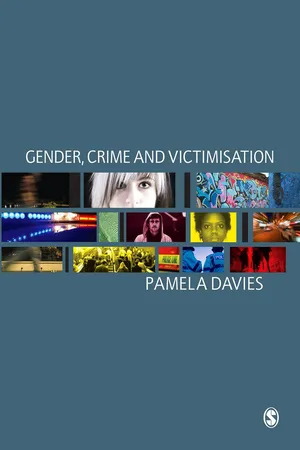Social Sciences
Victimisation
Victimisation refers to the process of making someone a victim, often through mistreatment, harassment, or abuse. In the social sciences, victimisation is studied to understand its causes, impact on individuals and communities, and ways to prevent and address it. This concept encompasses various forms of victimisation, including physical, emotional, and financial harm.
Written by Perlego with AI-assistance
Related key terms
9 Key excerpts on "Victimisation"
- eBook - ePub
The Citizen and the State
Criminal Justice and Civil Liberties in Conflict
- Angus Nurse(Author)
- 2020(Publication Date)
- Emerald Publishing Limited(Publisher)
There are conflicting debates about whether, by necessity, criminal justice places low priority on victims needs or prioritises victims over any fairness to alleged offenders. Victimisation ‘can go beyond a single incident so that victims may experience ongoing social marginalization, stigmatization, disempowerment, and social injustice’ (Spalek, 2017: 2). Victimology's advantage as the study of victims (Zedner, 2002) is that it focuses attention on the victim, so that crime and criminal justice policy not only considers how to address the behaviour of the offender or ways to reduce crime but also considers the personal and social effects of crime upon its victims. Fear of crime is a significant factor in crime and criminal justice bodies, and criminologists investigating Victimisation rates have been able to identify that certain groups in society are disproportionately more likely to suffer crime and thus have a justifiable fear of Victimisation. In addition, victimology and Victimisation theories note that Victimisation includes a wide range of perspectives on unfair treatment that arguably extends to the treatment of suspects and offenders and is not confined to crime victims. As Spalek (2017: 4) notes, the UN Declaration of Basic Principles of Justice for Victims of Crime and Abuse of Power also considers the extent to which Victimisation occurs as a consequence of crime and the abuse of economic and political power. Thus, Victimisation discourse should consider a wide range of Victimisation, including the extent to which citizens are victimised by oppressive criminal justice processes and abuses of criminal justice powers. This is the case even where the victim might be charged with a criminal offence - eBook - ePub
Restoring Harm
A Psychosocial Approach to Victims and Restorative Justice
- Daniela Bolívar(Author)
- 2019(Publication Date)
- Routledge(Publisher)
As we can observe, the DSM’s definition of trauma could be applied to different types of situations, e.g. natural disasters. However, can we argue that a natural disaster does not differ in nature from crime-caused Victimisation? This question has been an issue of debate within the victimological field for years. In 1997, in the context of the Ninth International Symposium of Victimology, Van Dijk (1999) distinguished between general and penal victimology. According to him, general victimology was concerned with the prevention of Victimisation in a wide sense. The first representative of this approach was Mendelsohn (see, for example, Mendelsohn, 1976), who advocated the development of a victimological discipline independent of criminology and criminal law. On the contrary, penal victimology studies incidents defined by the law as unlawful acts, and focuses on the interaction between the victim and the offender. In the same vein, Fattah (1991) distinguishes between criminal and non-criminal Victimisation. Although criminal Victimisation is defined as ‘victimization caused by, or resulting from, a criminal offense, which is act committed in violation of the criminal law’ (Fattah, 1991, p. 10), non-criminal Victimisation would involve other types of harmful acts. For Fattah (1991) this distinction is necessary in order to delineate clearly the area of study: victimology as a branch of criminology.Given these distinctions, the question emerges of whether different types of Victimisation will lead to different types of consequence. As Fattah (1991) points out, the question here is not whether one type of Victimisation is more serious or harmful, but rather it refers to identifying the specificity of criminal Victimisation. Some have argued that there are reasons to believe that Victimisation in the context of crime may have specific consequences that justify an independent and specific scientific field of research. One of these authors is Strobl (2010). He argues that to consider a situation as fitting into the definition of (criminal) Victimisation, there are five required criteria: (a) an identifiable single event, (b) an individual’s negative evaluation, (c) the uncontrollable character of the event, (d) the attribution to a personal or social offender, and (e) the violation of a socially shared norm.This list suggested by Strobl (2010) opens the door to a discussion about the essence of criminal Victimisation. Although some of these principles may be shared by other traumatic events (e.g. an earthquake is a single, negative and uncontrollable event), not all of them seem to be valid for certain types of Victimisation. For example, a female adolescent who has been raped by her progenitor since her early childhood has certainly experienced a Victimisation that cannot be attributed to a unique and single event. Last, we could argue that what seems to be a unique characteristic of a criminal Victimisation experience is its attribution to a personal or institutional offender, that is criminal Victimisation involves an interaction in which harm has been caused by another human being. - John Muncie, David Wilson(Authors)
- 2013(Publication Date)
- Routledge-Cavendish(Publisher)
epistemologies) that have underpinned social research in general. We call these positivist (or orthodox), interpretivist and critical theories of knowledge into which categories the wide number of theoretical perspectives on crime and victims (and indeed all aspects of social life) can be placed. This schema quite closely follows that provided by Walklate (1998), although we will identify some important points of difference.Finally, we will illustrate the ways in which different theories of knowledge have been used in relation to the consideration of victims by examining two important areas of Victimisation: domestic violence and corporate crime. It is through the consideration of these issues that we will question the notion that the state takes all Victimisation equally seriously.Key Terms
The false dichotomies of the ‘victim’; victimology – the positivist, interpretivist and critical approach; domestic violence; justice for victims.Introduction: Conceptualisation Of The Term ‘Victim'
It is taken for granted that the term ‘criminal’ is the product of various processes and institutions involved in the term's social construction (Heidensohn, 1989 ). The traditional representation of the criminal is restrictively associated with demonic images of urban working class youth, such that the notion of criminality becomes synonymous with youth. Yet, however misconceived this association, it has consistently informed criminal justice policy. The messages inherent in a policy which so closely associates crime with young people support the construction of a ‘discourse of difference’, which articulates ‘youth’ as a problem to adult society rather than as citizens (Brown, 1998 and see Chapter 15 ). In other words, policy-makers can employ the term ‘criminal’ to confer not just a legal but also a social status in order to isolate and socially exclude those labelled.Similarly, the term ‘victim’ is also the product of social construction. It too confers a status and assigns a role for those so labelled. The term carries very significant social messages associated with vulnerability, powerlessness and passivity within interpersonal relationships. ‘Victim’ is a word which Quinney (1972) notes is loaded with meaning, and ‘concern with the victim has become a powerful motif in contemporary western societal responses to crime’ (Bottoms, 1983 : 172). The common sense meaning projects an idealised image of the young, the old and the infirm. Those members of society who fit this idealised image as ‘innocent victims’ are those most able to claim legitimacy as victims and thus entitlement to sympathy, support or compensation. ‘The ideal victim is, in my use of the term, a sort of public status of the same type and level of abstraction as that for example of a “hero” or “traitor”’ (Christie, 1986- eBook - ePub
- Nicholas Blagden(Author)
- 2012(Publication Date)
- Learning Matters(Publisher)
Each of these definitions carries with it its own set of implications for how to construe a ‘victim’. The first definition is perhaps the most common. The victim is blameless and the Victimisation was outside their control. The second definition begins to blame the victim; they are the victim of their own pursuits. The third is a victim who has been preyed upon by a predator (for instance, a child groomed for sexual purposes) or who has been duped (perhaps an elderly person duped by a confidence trickster). The final definition has a wider set of implications. The etymology of the word ‘victim’ has been traced to those who are sacrificed. The implication with this definition is that the victim is construed as helpless and passive. However, feminists who have been influential in establishing a more ‘critical’ victimology are opposed to such passive victim definitions:Not everyone who suffers Victimisation likes to think of themselves or be called victim. Feminists … prefer to speak of survivors, for a number of reasons. 1) Using the term survivor makes clear the seriousness of rape as, often, a life-threatening attack. 2) Public perceptions are shaped by terminology and the word ‘victim’ has notions of passivity, even of helplessness … using the word ‘victim’ to describe women takes away our power.(London Rape Crisis Centre, 1984, piv)In victimology there are three main definitions of victims: direct, indirect and secondary. Direct victims are those who have been transgressed against in a way that contravenes the law (Dignan, 2005). In short, they are the identifiable victims. In terms of policing practice, we are more concerned with this type of victim. There is a wealth of statistics about the prevalence of direct Victimisation, primarily from official statistics (e.g. police recorded data) and unofficial statistics (e.g. the British Crime Survey). There are various advantages and disadvantages in using these data sources, which will be expanded on in the next section. - eBook - ePub
- Sandra Walklate(Author)
- 2016(Publication Date)
- Routledge(Publisher)
vulnerability . We shall discuss each of these in turn.Primary Victimisation refers to the direct impact that a crime has on the victim. That impact may vary with the nature of the crime, of course, from physical injury, to financial loss, to loss of earnings as a result of the required involvement in the criminal justice process. However for some people this kind of impact is made worse by the stress, shock, and sense of invasion of privacy that may go along with burglary, along with feelings of fear, difficulty in sleeping, to the post-traumatic stress syndrome reported by some victims of rape. This kind of impact can sometimes be made worse by the way in which the criminal justice system responds to such victims. This is what is referred to as secondary Victimisation. Research has indicated that individuals who are involved in the criminal justice process, as either victims or witnesses, frequently feel let down by that process. This can happen in different ways from not being kept informed of what was happening in their case, to being treated unsympathetically by the professionals working in the criminal justice process, to not being believed when they are giving their evidence. These kinds of experiences all, arguably, add to the feelings of Victimisation. In other kinds of cases, like for example murder, the families of both the murderer and the murder victim can also feel victimised by their experiences both in relation to feelings of bereavement, to maybe being under suspicion themselves for what has happened, as well as just not being able to make sense of what has happened. All of this is referred to as indirect Victimisation. However, the extent to which any individual may experience crime in any of these ways is frequently connected with their personal or structural vulnerability. In other words, not all victims of crime will experience their Victimisation in the same way or with the same level of impact. Criminologists refer to the variations that can be found in people’s experiences as their vulnerability. - eBook - ePub
Victimology
Victimisation and Victims' Rights
- Lorraine Wolhuter, Neil Olley, David Denham(Authors)
- 2008(Publication Date)
- Routledge-Cavendish(Publisher)
English policy and discourse regarding the Victimisation of minority ethnic communities have developed against the backdrop of the Macpherson Report (1999) into the death of Stephen Lawrence, which proved to be a pivotal point in this discourse as well as in the way police relate to such Victimisation. The very existence of the term ‘institutional racism’, as well as the way in which the interpretation of this term has changed, demonstrates the extent to which values, perceptions and approaches to such Victimisation have changed from the time of the Scarman Report (1986) to the Macpherson Report (1999) and thereafter.The purpose of this chapter is three-fold. First, it examines minority ethnic persons’ experiences of primary Victimisation in the context of crime generally. Findings from the British Crime Survey are used to determine the extent to which black and minority ethnic (BME) groups are at greater risk of being victims of such crime and to what extent race is a defining factor in their risk of Victimisation. Second, it assesses the extent and impact of racially motivated crime. It highlights the fact that the wider British society and official institutions have only recently come to recognise and respond to crimes perpetrated against individuals because of their race, religion or cultural background and that, prior to such recognition, victims were left without effective protection. In addition, it considers the secondary Victimisation experienced by victims at the hands of criminal justice agencies, particularly the police. Finally, the chapter addresses the question whether the police have acted unjustly in the way in which they exercise their powers to stop and search minority ethnic people.Ethnicity, Victimisation and social distribution
Extent of ‘ordinary’ criminal Victimisation
In order to determine the extent to which members of BME groups are victims of crime generally, the BCS has employed ‘booster’ surveys. These surveys comprise the over-sampling of a particular group, in this case BME groups, by, for example, conducting more questionnaires in areas known to have high concentrations of such groups (Salisbury and Upson, 2004, p. 6). It appeared from the earlier booster reports that all BME groups are at greater risk of criminal Victimisation. - eBook - ePub
- Sandra Walklate, Sandra Walklate(Authors)
- 2017(Publication Date)
- Routledge(Publisher)
et al., 2016; Crossley, 2000).The role of narrative and self-understanding emphasises the importance Victimisation of understanding as an (individual) process of historical development, in which the aftermath of Victimisation is part of the narrative, rather than a conceptually separate reaction to it (Pemberton, 2015a). Both Victimisation and the reaction to Victimisation take place in time. Even when the repair efforts in the aftermath of Victimisation are fully successful and no physical, mental or moral scars remain, what lives on are the memory and the story of what has happened and their meaning. Severe instances of Victimisation become part of the fabric of a person’s life story, of the unfolding narrative of life. Like with other profound experiences, Victimisation contributes to this narrative, most often for worse, sometimes perhaps for better. The same is true for the social reaction, including that of the criminal justice process to Victimisation (Pemberton, 2016).The importance of action, choice and meaning
In this narrative, the actions and the choices of the victim are key, as is the manner in which the victim understands these actions and choices. Rather than viewing the victim as a will-less subject of outside forces, our radical victimology seeks to understand the victim on his or her own terms, in which he or she is the lead actor in the narrative under construction. The choices and actions are radical themselves. Radical in the terms of the Russian-English theorist Isaiah Berlin, because they defy principles, often involve striking a balance between incommensurable and incompatible values, and can provide a complete overhaul of the situation of the victim (Berlin, 1997a, 1997b). These are choices and actions that are connected to the victim’s own identity, own imagination, own interpretation of the situation. As one of us noted elsewhere, this bears similarity to the imaginative, open-ended, creative activity of playing (Pemberton, 2015a; see also Schechner, 1988; Sutton-Smith, 2001; Graeber, 2015). - eBook - ePub
- Nathan Hall(Author)
- 2013(Publication Date)
- Routledge(Publisher)
Hate Victimisation may involve one crime or, more likely, a great many crimes to the extent that it is not always clear where one ends and the next begins. It may also involve actions that border on being criminal offences but might not be easily defined or recognised as such (hence the inclusion of incidents in the official definitions employed in England and Wales). As we have seen, and will see again in due course, there is evidence to suggest that these events can nevertheless have a disproportionate effect on the victim and their community, and that the fear and intimidation that results can transcend far beyond just the moment when the incident or incidents occur. As Bowling (1999: 189) explains in his study of racist Victimisation in Newham, London: During the year January 1987 to January 1988, fifty-three incidents targeted against seven families in two streets were recorded by the police Ȧ The overwhelming majority of the incidents consisted of verbal abuse and harassment, egg throwing, damage to property, and door knocking. Conceived of as individual instances of offensive or threatening behaviour, and employing any kind of hierarchy of seriousness using legal categories, many of these incidents would be regarded as minor. However, in the context of the life of any individual family and most clearly in the life of a locality the repeated incidence of harassment is bound to have a cumulative effect. This example of course does not include those incidents that occurred but were not reported to the police, and also highlights a fundamental mismatch between the nature of many ‘hate’ crimes and the workings of the criminal justice system, which is a key issue to which I shall return in chapter seven - eBook - ePub
- Pamela Davies(Author)
- 2010(Publication Date)
- SAGE Publications Ltd(Publisher)
These explicit and implicit value judgements about ‘undeserving’ and ‘real’ victims and the CICS emphasis on moral desert as opposed to moral complicity (Rock, 2004) can be made sense of victimologically. Walklate (2007a) has explained how these types of assumptions about victims within victimology are connected to ‘domain assumptions’. Domain assumptions are deep seated, taken for granted beliefs that originated in the work of the founders of the discipline in the 1940s and 1950s. Von Hentig and Mendelsohn, for example, were concerned with identifying and differentiating victim characteristics and non-victim characteristics and with identifying victim traits in their attempt to understand the victim-offender relationship. The typologies they developed have been clearly described in the context of positivist victimology elsewhere (see Davies et al., 2003, 2007; Mawby and Walklate, 1994) and the world views dominating victimological discourse have proved a powerful legacy in subsequent research practices and theorising as well as in policy and practice responses connected to crime victims. Notions of victim proneness, victim precipitation, victim-blaming and victim provocation, victim culpability and lifestyle as compared and contrasted with the ideal victim are deeply embedded in the dominant ways of thinking about victimhood and the study of victims more generally. Such assumptions are core to the discipline of victimology and fit very comfortably alongside the domain assumptions that are at the heart of positivist criminology.Gendered unfairness
For feminist commentators in particular the legacy of the above domain assumptions, with their stereotypical implications about women and men as variously deserving/undeserving victims and their inherent sexism is particularly evident and troublesome. Victimologically, feminism provoked a very strong and effective grass roots response to female victims and survivors of domestic violence and sexual abuse from men. Rock and Reeves have suggested that responses other than the state compensation scheme and responses that seek to address needs that are met other than financially have been under resourced by the state as they are in the shadow of the state compensation scheme – the main plank of the government’s response to victims of crime (Rock, 1990). The needs of women and children and the Victimisation that occurs behind the closed and private doors of the home, for example, have been neglected by the state. It is largely the feminist movement and the voluntary sector that has attempted to breach this gap. Even where the state has recognised domestic violence there have been special eligibility considerations attached (the CICS was only amended in 1979, 15 years after the scheme was first created to allow victims of violence within the family to make claims, the lower threshold for CICS awards was generally £400 in 1983 but was £500 in the case of intra-family violence). These are just some of the real implications and consequences of the domain assumption problems which reflect a very male view of who real victims are and where Victimisation happens and this centring of maleness is also reflected in terms of who gets what help. The rules and eligibility criteria for state criminal injuries compensation therefore tend to embody the fundamental assumptions of the discipline of victimology.
Learn about this page
Index pages curate the most relevant extracts from our library of academic textbooks. They’ve been created using an in-house natural language model (NLM), each adding context and meaning to key research topics.
